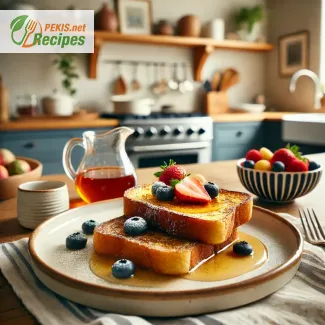
Few breakfast dishes can rival the comforting aroma and indulgent taste of homemade French toast. This timeless classic, cherished across the globe, offers a perfect balance of crispy edges and soft, custardy centers, making it a favorite for leisurely weekend breakfasts or festive brunches. Whether drizzled with pure maple syrup, topped with seasonal fruits, or sprinkled with a dash of powdered sugar, French toast is a dish that effortlessly combines simplicity and elegance.
A History Rooted in Tradition
French toast, known as "pain perdu" in French, meaning "lost bread," originated as a resourceful way to give stale bread a second life. Over time, it has transformed into a celebrated delicacy that crosses cultural boundaries. From Brioche and Challah to sourdough or rustic baguettes, the choice of bread contributes significantly to the final texture and flavor, allowing endless customization.
The Perfect Custard
The secret to achieving that luxurious texture lies in the custard. A harmonious blend of eggs, milk, cream, sugar, and a touch of vanilla creates the ideal coating. The bread absorbs this rich mixture, soaking up the flavors without becoming soggy. For an extra layer of indulgence, a pinch of cinnamon or freshly grated nutmeg can elevate the aroma, while a splash of orange zest adds a zesty twist.
The Art of Cooking
Achieving the golden-brown crust requires just the right amount of heat. Cooking French toast over medium heat in a mixture of butter and oil ensures even browning and prevents sticking. The balance of textures—crispy outside and tender inside—is where the magic happens. Whether you prefer thick slices of Brioche for a decadent breakfast or whole-grain bread for a healthier twist, mastering the cooking technique is key.
Versatility in Presentation
French toast is a culinary canvas, ready to be adorned with your favorite toppings. Classic pairings like fresh berries, whipped cream, or a drizzle of honey bring brightness and color. For a heartier option, consider caramelized bananas, toasted nuts, or a dollop of mascarpone. Each bite offers an opportunity to experiment with flavors and textures, making it a dish that never grows old.
A Nutritious Indulgence
Though indulgent, French toast can be made more nutritionally balanced by incorporating whole-grain bread, substituting cream with almond or oat milk, or sweetening the custard naturally with honey or maple syrup. With a few thoughtful adjustments, it can satisfy your cravings without compromising your health goals.
A Breakfast for All Occasions
French toast is more than just food—it’s an experience. Its versatility makes it suitable for intimate mornings, celebratory brunches, or even a quick dessert option. Paired with a cup of freshly brewed coffee or a sparkling mimosa, it transforms a simple meal into a memorable moment.
Why This Recipe Stands Out
This homemade French toast recipe emphasizes balance and flavor. It combines time-tested techniques with customizable elements, ensuring you achieve the perfect balance of crispy and custardy every time. Whether you're a seasoned chef or a kitchen novice, this recipe guarantees success and satisfaction.
From the first bite to the last, homemade French toast offers a taste of nostalgia, a touch of elegance, and endless opportunities for creativity. Whether you enjoy it with classic toppings or modern twists, it’s a dish that brings warmth and joy to every table.
- Prepare the custard: In a large mixing bowl, whisk together the eggs, milk, heavy cream, sugar, vanilla extract, cinnamon, and salt until smooth and well combined.
- Prepare the bread: Arrange the bread slices in a shallow dish large enough to hold them in a single layer. Pour the custard over the bread, allowing it to soak for 2–3 minutes. Flip the slices carefully to ensure even absorption.
- Preheat the pan: Heat a large skillet or griddle over medium heat. Add butter and oil, allowing them to melt and coat the surface evenly.
- Cook the French toast: Place the soaked bread slices onto the skillet. Cook for 2–3 minutes on each side, or until golden brown and crispy. Avoid overcrowding the pan—cook in batches if necessary.
- Serve immediately: Transfer the cooked slices to a serving platter. Garnish with your choice of toppings, such as fresh berries, powdered sugar, or a drizzle of maple syrup.
Tips to Perfect and Customize Homemade French Toast
Homemade French toast is a versatile dish that can be tailored to suit a variety of preferences, dietary needs, and flavor profiles. By making thoughtful adjustments to the ingredients and preparation techniques, you can elevate this classic dish to new heights. Below is a comprehensive guide to help you experiment with and refine the recipe.
Choosing the Right Bread
The choice of bread is the foundation of any French toast recipe, directly influencing its texture and flavor.
- Brioche or Challah: These rich, buttery breads create an indulgent and custardy texture, ideal for those who prefer a luxurious breakfast.
- Sourdough: Adds a subtle tanginess, which pairs beautifully with sweet toppings like maple syrup and fruit.
- Whole-grain Bread: A healthier alternative that introduces a nutty flavor and a firmer texture. Perfect for those looking to boost fiber intake.
- Gluten-free Bread: For those with gluten sensitivities, using a quality gluten-free bread ensures everyone can enjoy this dish without compromising flavor.
Tip: Always use slightly stale bread. This ensures the slices absorb the custard without becoming soggy.
Enhancing the Custard
The custard mixture is where the magic happens, as it imparts flavor and creaminess to the bread.
- Milk Alternatives: Substituting whole milk with almond, soy, or oat milk creates a dairy-free version while adding a unique nutty or creamy flavor.
- Sweeteners: Replace granulated sugar with honey, maple syrup, or coconut sugar for a natural sweetness and subtle flavor variations.
- Spices and Zest: A dash of cinnamon, nutmeg, or cardamom enhances the warmth of the dish, while orange or lemon zest introduces a refreshing citrus note.
Tip: For an extra creamy custard, add a tablespoon of mascarpone or cream cheese to the mixture.
Adjusting Cooking Techniques
The cooking process affects both the texture and presentation of the final dish.
- Butter vs. Oil: While butter adds flavor and helps achieve a golden crust, combining it with a neutral oil (like sunflower or grapeseed) prevents burning and ensures even browning.
- Cooking Temperature: Use medium heat to cook the French toast thoroughly without over-browning or drying it out.
Tip: If you prefer an ultra-crispy texture, lightly toast the bread slices before dipping them into the custard.
Creative Toppings for Flavor and Texture
Toppings transform French toast from simple to spectacular. Experiment with these options:
- Fresh Fruits: Seasonal fruits like berries, bananas, or peaches add natural sweetness and a pop of color.
- Nuts and Seeds: Toasted almonds, pecans, or pumpkin seeds provide a satisfying crunch.
- Sauces and Spreads: Drizzle with salted caramel, chocolate ganache, or fruit compote for indulgent flavors.
- Whipped Cream Alternatives: Replace traditional whipped cream with Greek yogurt or coconut cream for a tangy or tropical twist.
Tip: For a savory take, top with crispy bacon, poached eggs, or avocado slices.
Customizing for Dietary Needs
French toast can be easily adapted to accommodate dietary restrictions:
- Low-Sugar Version: Skip the added sugar in the custard and rely on natural sweetness from fruits and syrups.
- Low-Fat Option: Use skim milk or almond milk instead of heavy cream and minimize butter usage during cooking.
- Egg-Free Version: Replace eggs with a mixture of flaxseed meal and water (1 tbsp flaxseed + 3 tbsp water per egg) for a vegan-friendly dish.
Tip: Experiment with plant-based creamers for an egg-free and dairy-free custard with added richness.
Elevating Presentation
Presentation matters, especially for brunch gatherings or special occasions.
- Layered Stack: Stack slices with layers of fruit and whipped cream for a visually appealing presentation.
- Powdered Sugar Stencil: Use a stencil to dust powdered sugar in decorative patterns for a touch of elegance.
- Plating Style: Use rustic plates for a homey feel or modern dishes for a sleek, sophisticated look.
Tip: Serve French toast warm on pre-heated plates to preserve its texture and ensure a delightful eating experience.
The Impact of Small Changes
Every change you make to the recipe—whether it’s swapping ingredients or altering cooking techniques—affects the final outcome.
- Richer Flavors: Using cream in the custard or topping with rich sauces enhances the indulgence factor.
- Healthier Profiles: Incorporating whole-grain bread, reducing sugar, and adding fresh fruits makes French toast a more balanced meal.
- Distinct Aromas: Spices like cinnamon, nutmeg, and vanilla add depth and elevate the dish’s aroma.
Tip: Always taste and adjust the seasoning in your custard before dipping the bread to ensure a perfect balance of flavors.
Customizing homemade French toast allows you to create a dish that reflects your personal taste and preferences. By experimenting with breads, custards, and toppings, you can transform this timeless classic into a unique culinary masterpiece. Whether you’re aiming for a decadent brunch or a wholesome breakfast, these tips will help you achieve delicious results every time.
Allergens: Contains gluten (bread), eggs, and dairy.
Substitution Tips to Remove Allergens:
- Replace bread with gluten-free bread to make it gluten-free.
- Substitute almond or oat milk for whole milk and heavy cream to make it dairy-free.
- Use egg replacers or flaxseed meal mixed with water to replace eggs.
- Vitamin A: 300 IU – supports vision and immune health.
- Calcium: 120 mg – essential for strong bones and teeth.
- Iron: 2 mg – aids in oxygen transport in the blood.
- Vitamin D: 1 µg – promotes calcium absorption and bone health.
- Cinnamon: Contains cinnamaldehyde, a powerful antioxidant that reduces inflammation and supports heart health.
- Egg yolks: Provide lutein and zeaxanthin, antioxidants that promote eye health.
Enjoy this delicious recipe as a comforting breakfast or a sweet treat, and adapt it to suit dietary preferences or needs!





